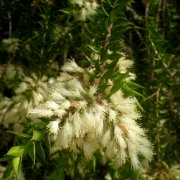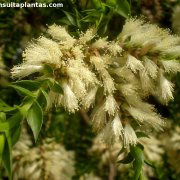Care of the tree Melaleuca styphelioides or Prickly paperbark |
|
The genus Melaleuca, family Myrtaceae, comprises 200 species of shrubs and small trees native to Australia. Some species are: Melaleuca styphelioides, Melaleuca nesophila, Melaleuca linariifolia, Melaleuca huegelii, Melaleuca ericifolia, Melaleuca megacephala, Melaleuca elliptica, Melaleuca alternifolia, Melaleuca armillaris, Melaleuca viridiflora. Common name: Prickly paperbark. This species is native to eastern Australia. They are evergreen trees with a rounded crown that reach 20 meters (61.6 feet) in height in their natural habitat; in the gardens they reach 15 meters (49.2 feet). The small, deep green leaves end in rigid points and are arranged in a spiral on the hanging branches. They produce numerous flower spikes with white or cream flowers. They can bloom in spring and early summer. The fruits are brown capsules. Prickly paperbark is used in public parks and streets, as isolated specimens, as shade trees, as windbreaks and next to waterways. It's ideal for Mediterranean coastal gardens. It resists pollution from cities. Melaleuca styphelioides prefer in a full sun exposure and in a Mediterranean climate. It resists occasional frosts. Prickly paperbark can grow in all types of soils: sandy, clayey, calcareous or acidic. Water moderately in spring and summer, waiting for the substrate to dry; the rest of the year Prickly paperbark is kept with rainwater. Melaleuca styphelioides does not need fertilizers. Prune after flowering to maintain a rounded appearance. Prickly paperbark is a resistant plant to the usual pests and diseases. Melaleuca styphelioides propagates from seeds sown in late winter or spring. |
Images of the tree Melaleuca styphelioides or Prickly paperbark |
Find plants
Melaleuca styphelioides or Prickly paperbark | Care and Growing
© 2025 FavThemes






